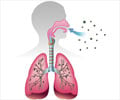Arthrobotrys oligospora, the fungus that survives on a diet of roundworm, has cancer-fighting power, discover researchers.

Zhang commonly looks to nature for solutions to the world's challenges. He and research associate Yongzhong Wang were examining A. oligospora's trapping mechanism for roundworms when they discovered the fungus secretes nanocomposites consisting of highly uniform nanoparticles. Nanoparticles are tiny particles that have been shown to be important in cancer therapies.
"Naturally occurring nanoparticles have drawn increasing interest from scientific communities for their biocompatibility. Due to their high surface-to-volume ratio, nanoparticles have demonstrated unique optical, thermal and electronic properties. In addition, their small size allows them to easily cross cell membranes, an essential requirement for cancer therapy," said Zhang.
The researchers investigated the fungal nanoparticles' potential as a stimulant for the immune system, and found through an in vitro study that the nanoparticles activate secretion of an immune-system stimulant within a white blood cell line.
They also investigated the nanoparticles' potential as an antitumor agent by testing in vitro the toxicity to cells using two tumor cell lines, and discovered nanoparticles do kill cancer cells.
According to Zhang, nature faces many diseases, and offers rich mechanisms for curing them as a result of evolution. Nature-based nanostructures possess near endless diversity, which may offer novel solutions for therapeutic applications.
Advertisement
The researchers' approach promises to open up a new avenue for controlling the synthesis of organic nanoparticles using synthetic biology.
Advertisement
Their findings are published in this month's edition of Advanced Functional Materials.
Source-ANI














